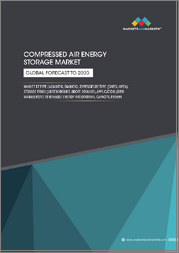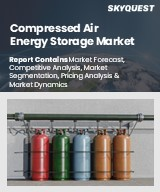
|
시장보고서
상품코드
1424965
세계 압축 공기 에너지 저장(CAES)의 시장 : 시장 규모, 점유율분석(유형별·저장방법별·용도별), 산업 수요 예측(-2030년)Compressed Air Energy Storage Market Size and Share Analysis by Type, Storage, Application - Global Industry Demand Forecast to 2030 |
||||||
압축 공기 에너지 저장(CAES) 시장은 2024년부터 2030년까지 복합 연간 성장률(CAGR) 23.7%로 성장할 전망이고 2030년에는 266억 530만 달러에 달할 것으로 예측됩니다. 이는 세계 인구 증가에 따른 전력 수요의 전반적인 급증 때문입니다. 동시에 석탄 기반 발전의 대체 수단에 대한 요구가 커지고 있는 것도 시장의 주요 촉진요인이 되고 있습니다.
CAES는 에너지를 한 번 저장하고 나중에 사용하는 것입니다. 게다가 단열 CAES는 이 기술의 고도의 변이이며, 단열 상태(압축·팽창 프로세스 중에 환경에의 열전달이 없는 것)를 유지하는 것에 중점을 두고 있습니다. 그 결과 에너지 손실이 최소화되고 효율이 향상됩니다. 또한 전력 수요의 변화에 신속하게 대응할 수 있기 때문에 계통 안정성이라는 이점도 있어 피크 부하의 관리에도 도움이 됩니다.
기존 CAES 저장 시장 점유율 확대:
예측 기간 동안 기존 CAES의 점유율이 커질 것으로 예상됩니다. 그 이유는 기존 기술이 비용 효율성과 신뢰성이 우수하다는 것입니다. 이 방법은 압축 공기를 저장하기 위해 대규모 지하층을 사용합니다. 게다가 이 방법은 운영 효율이 높다는 특징이 있어 세계에서 널리 이용되고 있습니다.
마찬가지로 액체 가스도 CAES의 혁신적인 접근 방식이기 때문에 지난 10년 동안 견고한 복합 연간 성장률(CAGR) 성장할 것으로 보입니다. 액체 가스는 저온 액체 공기 및 액체 질소에 에너지를 저장하기 때문에 기존의 접근법과 다릅니다. 저장된 에너지는 전기가 필요할 때 가스로 변환됩니다. 기본적으로 에너지 변환 효율이 높고 환경에 미치는 영향은 압축에 사용하는 에너지 원과 사용하는 극저온 액체의 유형에 따라 다릅니다. 따라서 깨끗한 에너지원을 동력원으로 하는 경우, 액체가스식 CAES는 더욱 큰 환경상의 이점을 가져올 수 있습니다.
에너지 관리 용도가 시장을 독점 :
에너지 관리는 압축 공기 에너지 저장 시장에서 용도별로 압도적 점유율을 차지하는 카테고리입니다. 이는 CAES가 화석연료 기반 에너지원에 대한 의존도를 줄이기 때문에 발전소 활용에 큰 잠재력이 있기 때문입니다. 따라서 주파수 제어, 전압 조정, 부하 시프트, 피크 부하 관리 등의 여러 기능을 대규모 발전소에서 사용할 수 있습니다.
이 보고서는 세계 압축 공기 에너지 저장(CAES) 시장을 분석하고 시장의 기본 구조, 최신 상황 및 주요 촉진 및 억제요인, 전 세계 및 지역별 및 주요 국가 시장 규모 동향 전망(금액 베이스(2017년-2030년)), 유형별·저장방법별·용도별 상세 동향, 현재 시장 경쟁 구도, 주요 기업 프로파일 등의 정보를 전해드립니다.
목차
제1장 조사 범위
제2장 조사 방법
제3장 주요 요약
제4장 시장 지표
제5장 업계 전망
- 시장 역학
- 동향
- 성장 촉진요인
- 억제요인/과제
- 성장 촉진요인/억제요인의 영향 분석
- 신형 코로나 바이러스 감염(COVID-19)의 영향
- Porter's Five Forces 분석
제6장 시장
- 개요
- 시장수익 : 유형별(2017년-2030년)
- 시장 수익 : 저장 방법별(2017년-2030년)
- 시장 수익 : 용도별(2017년-2030년)
- 시장 수익 : 지역별(2017년-2030년)
제7장 북미 시장
- 개요
- 시장수익 : 유형별(2017년-2030년)
- 시장 수익 : 저장 방법별(2017년-2030년)
- 시장 수익 : 용도별(2017년-2030년)
- 시장수익 : 국가별(2017년-2030년)
제8장 유럽 시장
제9장 아시아태평양 시장
제10장 라틴아메리카 시장
제11장 중동 및 아프리카(MEA) 시장
제12장 미국 시장
- 개요
- 시장수익 : 유형별(2017년-2030년)
- 시장 수익 : 저장 방법별(2017년-2030년)
- 시장 수익 : 용도별(2017년-2030년)
제13장 캐나다 시장
제14장 독일 시장
제15장 프랑스 시장
제16장 영국 시장
제17장 이탈리아 시장
제18장 스페인 시장
제19장 일본 시장
제20장 중국 시장
제21장 인도 시장
제22장 호주 시장
제23장 한국 시장
제24장 브라질 시장
제25장 멕시코 시장
제26장 사우디아라비아 시장
제27장 남아프리카 시장
제28장 아랍에미리트(UAE) 시장
제29장 경쟁 구도
- 시장 진출기업과 그 제공 제품/서비스의 일람
- 주요 기업의 경쟁 벤치마킹
- 주요 기업의 제품 벤치마킹
- 최근의 전략 전개 상황
제30장 기업 프로파일
- Siemens AG
- Hydrostor Inc.
- Pacific Gas and Electric Company
- Apex Compressed Air Energy Storage LLC
제31장 부록
BJH 24.02.26The compressed air energy storage market is projected to grow at a CAGR of 23.7% during 2024-2030, to reach USD 26,605.3 million by 2030. This will be due to the increase in the global population, accompanied by a surge in the overall power demand. Along with this, the escalating need for alternatives to coal-based energy generation is a major driver for the market.
Compressed air energy storage (CAES) permits energy to be stored once and utilized later. Moreover, adiabatic CAES is an advanced variation of this technology as it focuses on maintaining adiabatic conditions, which are characterized by no heat transfer to the environment during the compression and expansion process. This results in the minimization of energy loss and increase in efficiency. It also offers the advantage of grid stability as it can swiftly respond to the changes in electricity demand, hence helping manage peak loads.
Traditional CAES Storage To Have Larger Market Share
The traditional category is expected to have the larger share during the forecast period, based on storage. This is because the conventional technology is cost-effective and reliable. This method involves the use of large underground geological formations to store compressed air. Moreover, the approach is characterized by its high operational efficiency, due to which it is widely used around the world.
Likewise, the liquid gas category will witness a robust CAGR over this decade, as it is an innovative approach to CAES. It is different from the traditional approach as it stores energy in liquid air or liquid nitrogen at low temperatures. The stored energy is further converted to a gas when electricity is required. Essentially, it has a high energy conversion efficiency, and its environmental impact depends on the energy source utilized for compression and the type of cryogenic liquid used. Thus, when powered by clean energy sources, liquid-gas CAES has the potential to deliver even more-significant environmental advantages.
Energy Management Application Dominates Market
Energy management is the dominating category in the compressed air energy storage market, under segmentation by application. This is because CAES holds a significant potential for application in power plants as it reduces the dependence on fossil-fuel-based
energy sources. Thus, it could be utilized in large power plants for multiple functions, such as frequency control, voltage regulation, load shifting, and peak load management.
Some of the key players in the global compressed air energy storage market are Siemens AG, Hydrostor Inc., Pacific Gas and Electric Company, and Apex Compressed Air Energy Storage LLC.
Table of Contents
Chapter 1. Research Scope
- 1.1. Research Objectives
- 1.2. Market Definition
- 1.3. Analysis Period
- 1.4. Market Size Breakdown by Segments
- 1.4.1. Market size breakdown, by type
- 1.4.2. Market size breakdown, by storage
- 1.4.3. Market size breakdown, by application
- 1.4.4. Market size breakdown, by region
- 1.4.5. Market size breakdown, by country
- 1.5. Market Data Reporting Unit
- 1.5.1. Value
- 1.6. Key Stakeholders
Chapter 2. Research Methodology
- 2.1. Secondary Research
- 2.1.1. Paid
- 2.1.2. Unpaid
- 2.1.3. P&S Intelligence database
- 2.2. Primary Research
- 2.3. Market Size Estimation
- 2.4. Data Triangulation
- 2.5. Currency Conversion Rates
- 2.6. Assumptions for the Study
- 2.7. Notes and Caveats
Chapter 3. Executive Summary
Chapter 4. Market Indicators
Chapter 5. Industry Outlook
- 5.1. Market Dynamics
- 5.1.1. Trends
- 5.1.2. Drivers
- 5.1.3. Restraints/challenges
- 5.1.4. Impact analysis of drivers/restraints
- 5.2. Impact of COVID-19
- 5.3. Porter's Five Forces Analysis
- 5.3.1. Bargaining power of buyers
- 5.3.2. Bargaining power of suppliers
- 5.3.3. Threat of new entrants
- 5.3.4. Intensity of rivalry
- 5.3.5. Threat of substitutes
Chapter 6. Global Market
- 6.1. Overview
- 6.2. Market Revenue, by Type (2017-2030)
- 6.3. Market Revenue, by Storage (2017-2030)
- 6.4. Market Revenue, by Application (2017-2030)
- 6.5. Market Revenue, by Region (2017-2030)
Chapter 7. North America Market
- 7.1. Overview
- 7.2. Market Revenue, by Type (2017-2030)
- 7.3. Market Revenue, by Storage (2017-2030)
- 7.4. Market Revenue, by Application (2017-2030)
- 7.5. Market Revenue, by Country (2017-2030)
Chapter 8. Europe Market
- 8.1. Overview
- 8.2. Market Revenue, by Type (2017-2030)
- 8.3. Market Revenue, by Storage (2017-2030)
- 8.4. Market Revenue, by Application (2017-2030)
- 8.5. Market Revenue, by Country (2017-2030)
Chapter 9. APAC Market
- 9.1. Overview
- 9.2. Market Revenue, by Type (2017-2030)
- 9.3. Market Revenue, by Storage (2017-2030)
- 9.4. Market Revenue, by Application (2017-2030)
- 9.5. Market Revenue, by Country (2017-2030)
Chapter 10. LATAM Market
- 10.1. Overview
- 10.2. Market Revenue, by Type (2017-2030)
- 10.3. Market Revenue, by Storage (2017-2030)
- 10.4. Market Revenue, by Application (2017-2030)
- 10.5. Market Revenue, by Country (2017-2030)
Chapter 11. MEA Market
- 11.1. Overview
- 11.2. Market Revenue, by Type (2017-2030)
- 11.3. Market Revenue, by Storage (2017-2030)
- 11.4. Market Revenue, by Application (2017-2030)
- 11.5. Market Revenue, by Country (2017-2030)
Chapter 12. U.S. Market
- 12.1. Overview
- 12.2. Market Revenue, by Type (2017-2030)
- 12.3. Market Revenue, by Storage (2017-2030)
- 12.4. Market Revenue, by Application (2017-2030)
Chapter 13. Canada Market
- 13.1. Overview
- 13.2. Market Revenue, by Type (2017-2030)
- 13.3. Market Revenue, by Storage (2017-2030)
- 13.4. Market Revenue, by Application (2017-2030)
Chapter 14. Germany Market
- 14.1. Overview
- 14.2. Market Revenue, by Type (2017-2030)
- 14.3. Market Revenue, by Storage (2017-2030)
- 14.4. Market Revenue, by Application (2017-2030)
Chapter 15. France Market
- 15.1. Overview
- 15.2. Market Revenue, by Type (2017-2030)
- 15.3. Market Revenue, by Storage (2017-2030)
- 15.4. Market Revenue, by Application (2017-2030)
Chapter 16. U.K. Market
- 16.1. Overview
- 16.2. Market Revenue, by Type (2017-2030)
- 16.3. Market Revenue, by Storage (2017-2030)
- 16.4. Market Revenue, by Application (2017-2030)
Chapter 17. Italy Market
- 17.1. Overview
- 17.2. Market Revenue, by Type (2017-2030)
- 17.3. Market Revenue, by Storage (2017-2030)
- 17.4. Market Revenue, by Application (2017-2030)
Chapter 18. Spain Market
- 18.1. Overview
- 18.2. Market Revenue, by Type (2017-2030)
- 18.3. Market Revenue, by Storage (2017-2030)
- 18.4. Market Revenue, by Application (2017-2030)
Chapter 19. Japan Market
- 19.1. Overview
- 19.2. Market Revenue, by Type (2017-2030)
- 19.3. Market Revenue, by Storage (2017-2030)
- 19.4. Market Revenue, by Application (2017-2030)
Chapter 20. China Market
- 20.1. Overview
- 20.2. Market Revenue, by Type (2017-2030)
- 20.3. Market Revenue, by Storage (2017-2030)
- 20.4. Market Revenue, by Application (2017-2030)
Chapter 21. India Market
- 21.1. Overview
- 21.2. Market Revenue, by Type (2017-2030)
- 21.3. Market Revenue, by Storage (2017-2030)
- 21.4. Market Revenue, by Application (2017-2030)
Chapter 22. Australia Market
- 22.1. Overview
- 22.2. Market Revenue, by Type (2017-2030)
- 22.3. Market Revenue, by Storage (2017-2030)
- 22.4. Market Revenue, by Application (2017-2030)
Chapter 23. South Korea Market
- 23.1. Overview
- 23.2. Market Revenue, by Type (2017-2030)
- 23.3. Market Revenue, by Storage (2017-2030)
- 23.4. Market Revenue, by Application (2017-2030)
Chapter 24. Brazil Market
- 24.1. Overview
- 24.2. Market Revenue, by Type (2017-2030)
- 24.3. Market Revenue, by Storage (2017-2030)
- 24.4. Market Revenue, by Application (2017-2030)
Chapter 25. Mexico Market
- 25.1. Overview
- 25.2. Market Revenue, by Type (2017-2030)
- 25.3. Market Revenue, by Storage (2017-2030)
- 25.4. Market Revenue, by Application (2017-2030)
Chapter 26. Saudi Arabia Market
- 26.1. Overview
- 26.2. Market Revenue, by Type (2017-2030)
- 26.3. Market Revenue, by Storage (2017-2030)
- 26.4. Market Revenue, by Application (2017-2030)
Chapter 27. South Africa Market
- 27.1. Overview
- 27.2. Market Revenue, by Type (2017-2030)
- 27.3. Market Revenue, by Storage (2017-2030)
- 27.4. Market Revenue, by Application (2017-2030)
Chapter 28. U.A.E. Market
- 28.1. Overview
- 28.2. Market Revenue, by Type (2017-2030)
- 28.3. Market Revenue, by Storage (2017-2030)
- 28.4. Market Revenue, by Application (2017-2030)
Chapter 29. Competitive Landscape
- 29.1. List of Market Players and their Offerings
- 29.2. Competitive Benchmarking of Key Players
- 29.3. Product Benchmarking of Key Players
- 29.4. Recent Strategic Developments
Chapter 30. Company Profiles
- 30.1. Siemens AG
- 30.1.1. Business overview
- 30.1.2. Product and service offerings
- 30.1.3. Key financial summary
- 30.2. Hydrostor Inc.
- 30.2.1. Business overview
- 30.2.2. Product and service offerings
- 30.2.3. Key financial summary
- 30.3. Pacific Gas and Electric Company
- 30.3.1. Business overview
- 30.3.2. Product and service offerings
- 30.3.3. Key financial summary
- 30.4. Apex Compressed Air Energy Storage LLC
- 30.4.1. Business overview
- 30.4.2. Product and service offerings
- 30.4.3. Key financial summary
Chapter 31. Appendix
- 31.1. Abbreviations
- 31.2. Sources and References
- 31.3. Related Reports



















